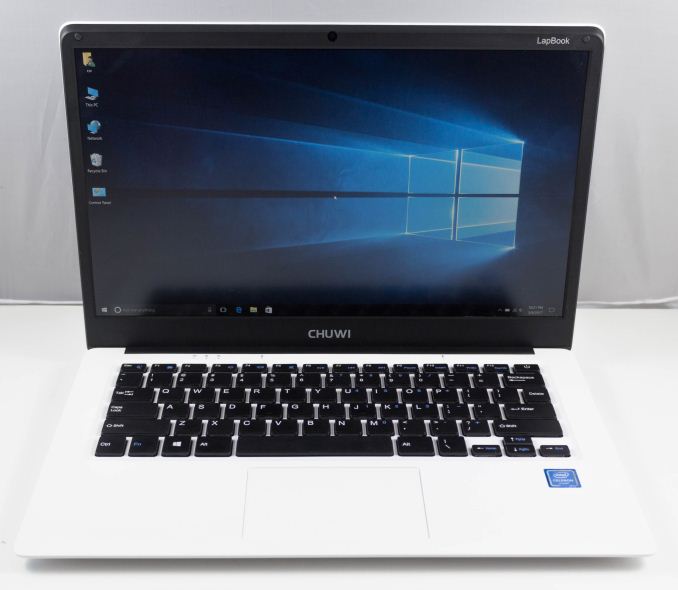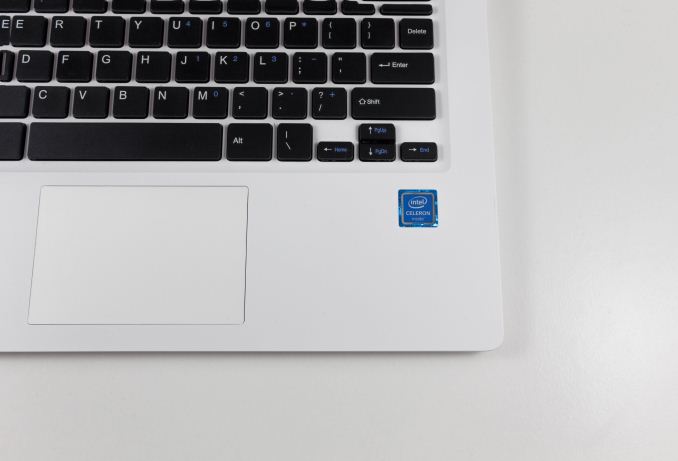The Chuwi LapBook 14.1 Review: Redefining Affordable
by Brett Howse on March 10, 2017 8:00 AM EST
In this industry, it is all too easy to focus only on the high end of the PC market. Manufacturers want to show off their best side, and often provide samples of high-end, high-expense devices more than their other offerings. While these devices are certainly exciting, and can set the bar for how products should perform, there is definitely a gap compared to being able to review the other end of the market. A couple of years ago, HP launched the HP Stream 11, which at the time was a solid entry into a new price bracket, but it was, of course, a device with a lot more compromise than HP’s more expensive offerings. But, HP was not sampling the Stream 11 to very many people, as can be the case on devices like this, so I went ahead and purchased the Stream 11 for review.
When Chinese manufacturer Chuwi reached out with an opportunity to take a look at the Chuwi LapBook 14.1, it was a great chance to see how this market has evolved over the last several years, and to see how another manufacturer tackles the inescapable compromise of this end of the market. The Chuwi LapBook 14.1 offers a lot of computer for the money. The price has varied a bit over the last six weeks, but it has been as low as $249.99 USD, and is currently for sale for $264.99.
As its name would suggest, the Chuwi LapBook 14.1 is a 14.1-inch laptop, featuring an Intel Celeron N3450 CPU, which is the latest 14 nm Atom cores, codenamed Goldmont, and in this case, it’s a quad-core model which can hit 2.2 GHz in its 6-Watt TDP. We’ll dig into Goldmont more in a bit, but Goldmont in this configuration is known as Apollo Lake, and it features Intel HD Graphics 500 with 12 EUs up to 700 MHz. The LapBook also features 4 GB of RAM, and 64 GB of eMMC storage, as well as a MicroSD slot for expansion up to another 128 GB of storage.
Where the Chuwi LapBook stands out though is in the display. The LapBook features a 1920x1080 IPS panel, when most laptops in this price range feature 1366x768 TN displays. Most, but not all, with HP offering a Carrizo-L powered 14-inch notebook with IPS as well, so while Chuwi is not alone in this market, the IPS display is a huge step up over the TN competition. The LapBook also features 8 mm bezels, which is quite a bit thinner than most laptops, and especially laptops at the $250-$300 price range.
| Chuwi LapBook 14.1 | |
| CPU | Intel Celeron N3450 4C/4T 1.1-2.2 GHz 2MB L2 Cache 6W TDP |
| GPU | Intel HD Graphics 500 12 Execution Units (Gen 9) 200-700 MHz |
| Memory | 4 GB Dual-Channel |
| Display | 14.1" 1920x1080 IPS 60 Hz |
| Storage | 64 GB eMMC Expandable up to +128GB microSD |
| I/O | 1 x USB 3.0 Port 1 x USB 2.0 Port 1 x micro HDMI micro SD Card Slot 1 x Headset Jack |
| Dimensions | 330 x 227 x 9-20 mm 13 x 8.93 x 0.35-0.79 inches |
| Weight | 1.5 kg / 3.3 lbs |
| Battery | 45 Wh, 24W AC Adapter |
| Wireless | Intel Dual Band Wireless-AC 3165 1x1 with Bluetooth 4.2 |
| Price | $250-270 USD |
Chuwi has also gone with an 802.11ac wireless card from Intel, which is good to see. It’s a single channel only, but assuming you have an 802.11ac router, it will offer a lot more performance than an 802.11n model.
Overall, the Chuwi LapBook packs quite a bit in for just over $250, with 64 GB of storage, 4 GB of RAM, a FHD IPS display, and all in a 9-20mm thick package weighing in at a few pounds. It’s very portable, it has decent specifications, and the price is good, but specifications don’t make a computer, so let’s dig into it a bit more to see how it stacks up.
Chuwi is offering a $24 discount code on Amazon for AnandTech readers. Please enter the code TIUGTN5W at checkout










75 Comments
View All Comments
BrokenCrayons - Friday, March 10, 2017 - link
Here's a link to a reviewer that tested the Lapbook with Ubuntu:http://www.cnx-software.com/2017/02/07/installing-...
The results look promising.
tipoo - Friday, March 10, 2017 - link
If I could don my tin hat for only a few seconds...Has anyone ever looked at the outbound traffic on these lesser known Chinese designed electronics? There was some controversy with Xiaomi router traffic even iirc.
BrokenCrayons - Friday, March 10, 2017 - link
A quick search didn't turn up anything. I don't think they're selling in large enough numbers to attract a lot of interest in sniffing their outbound traffic. It's a reasonable concern, but I don't think Chuwi would actively attempt to perform mass data collection. That's a pretty widely cast net that wouldn't reap much value because you're probably looking at largely home users. The data collection would be almost entirely uninteresting. Maybe some social networking, shopping and general web browsing, someone's hidden inappropriate photos and videos...that kind of thing isn't worth a lot unless you have a specific target in mind and in that case its more prudent to isolate that individual rather than everyone buying your products. Probably the best you'd get is access to someone's personal finances and a deep enough investigation would do a lot of damage to business interests. It's really worth more to establish a good brand reputation and land decent numbers of sales than it is to go through the trouble of getting one or two generations of hardware out there to a small number of people that probably are collectively deep in debt and have little liquid cash.fanofanand - Monday, March 13, 2017 - link
I think the concern would lay more on the government's involvement (The Chinese government is involved with virtually all exported electronics). I agree with every single thing you wrote, but Chinese businesses don't all exist for the sole purpose of making money.Bullwinkle J Moose - Friday, March 10, 2017 - link
Good point tipooThis article just today and all the turmoil at Samsung and S Korea makes me think we should be looking out for malware popping up in other places
Even places we have considered to be quite reliable up till now
https://arstechnica.com/security/2017/03/preinstal...
Things seem to be escalating but I'm sure the CIA will put a start to any malware threats to this Country (LOL)
Murloc - Saturday, March 11, 2017 - link
to make such low costs devices you buy standard chips so I don't think they can put anything in it.If chinese-designed chips have espionage software in them, then a bunch of the network infrastructure we rely on is bugged because huawei is everywhere in them. Also phones that use mediatek devices.
So worrying doesn't make sense, also because it's well-known from the various leaks and stuxnet that the NSA and the CIA and mossad don't need hardware to snoop or damage critical infrastructure so the chinese don't either.
Meteor2 - Friday, March 10, 2017 - link
Nice review of a nice machine.Good to read about how Goldmont finally played out. MS must've been pissed when Intel cancelled Broxton, but I imagine it's now Intel's turn with Windows on 835 coming. It's a shame Intel did what they did as Goldmont appears to be good silicon.
aryonoco - Friday, March 10, 2017 - link
The main competition in this price category is Chromebooks.The fact that you are pitting this device in your comparisons against a Yoga 3 Pro and a Asus UX305, and not a single Chromebook, says all that needs to be said about the sorry state of AT these days.
Sure, I miss Anand & Brian, but when they left we got Jarred Walton Andrei Frumusanu, who at least knew what they were talking about. Ryan, these new writers you have hired do not stack up.
Ian Cutress - Saturday, March 11, 2017 - link
To clarify an obvious error: Jarred was here 10 years, and both Andrei and Brett were here well before Anand left. Brett has been one of our freelance editors for over two years and attends events such as CES and Build as our Senior Laptop Editor. If you dislike the context of this review, sure, I'll grant you that opinion, but he has a large body of great work under him already. He's not new, he knows the score.On the testing front, it's a factor of what we get in for testing at any given time. Ultimately 90% of the time vendors want us to test their premium units, not something low cost. And there's a thousand low-cost options out there to potentially compare them against. When you've got a freelancer with time for 6-10 reviews a year, most of those will be high-end premium reviews. So if something interesting comes along, even at a super low price point, you compare against what you can or have at the time.
Which in this case, the HP Stream 11 is the perfect comparison point for all these benchmarks. The Yoga/Surface are added to show the comparison to what a high-end notebook investment would be, which users always want to know without having to dig through our results database. We do have some Chromebooks in our database, but they are old. We haven't tested one in a long while (so we don't have one in for retesting), and they were all done by a different reviewer over 1000 miles away at the time. Most of the Chromebooks are Atom based anyway, which is why the HP Stream is still a relevant comparison. Heck, I even recommended the Stream 11 to someone I know a couple of weeks ago, and she loves it (especially now there's a 360-degree hinge version).
fanofanand - Monday, March 13, 2017 - link
I get what the OP is saying but it is misguided in this case. Brett's reviews are solid. Some of the review product choices (case and PSU reviews) have been questionable but other than mobile reviews I haven't seen a real decline in the quality of Anandtech's journalism. Yes, they have had some major misses in the last year (especially in the GPU space) but what they have actually written has been fairly solid content.